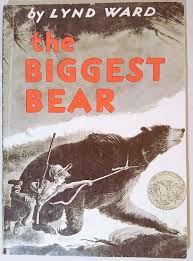Lynd Ward and His Wordless Stories
Listen to the Recess! Clip
| Author | Rita Smith |
| Air Date | 6/28/2004 |

Lynd Ward and His Wordless Stories Transcript
Lynd Ward, an illustrator of both children’s and adult books, was born in 1905 in Chicago. His father was a Methodist minister. As a baby, he was often sick and when he was a year old, his parents, thinking some country air would do him good, bought a summer cabin in the Canadian woods northeast of Sault Ste Marie. When they returned that first fall to Chicago, Lynd was in good health and they continued summer visits to the cabin as long as they remained in the Midwest.
Growing up in a minister’s household, Ward wasn’t allowed to read the Sunday comic strips, so he spent long Sunday afternoons lying flat on the floor on the living-room rug pouring over two books: One was a book that had a picture and a poem on each page. Ward turned the pages looking at the pictures but ignoring the poetry, which seemed superfluous. The other book was Gustave Dore’s Gallery of Bible Pictures. He seldom bothered to read the accompanying text of this book either, but, he wrote later, “I can still remember the violence of my emotion as I turned the pages and moved through the book absorbing those images and living with them.”1 His experiences in the north woods and with the books of pictures raised his interest both in nature and in reading and he also developed a strong interest in art, spurred on by his astonishing discovery in the first grade that the name Ward was really Draw spelled backwards.2
During a 50-year career, Ward illustrated over 100 books for both children and adults. His best known children’s book is The Biggest Bear, a story set in the northern woods, about a boy, Johnny Orchard, who sets out to shoot a big bear so his family can have a bearskin on the side of their barn like everyone else in the neighborhood. But instead of a big bear, he finds a cub, takes it home, and makes it a pet. Needless to say, the bear grows to an enormous size, becomes a nuisance to everyone and is eventually sent to a zoo where Johnny visits him often and feeds him maple sugar. Ward was a perfectionist and worked meticulously on each drawing. He threw away the first ten drawings he made for The Biggest Bear because he was unhappy with them and started over. May McNeer, his wife, wrote of him, “He never approaches a job with an estimate of the time it will take, but only with a desire to do it well, and to learn as much as possible.”3 Perhaps remembering those afternoons on the living-room floor when pictures carried the day, Ward finished The Biggest Bear first as simply a sequence of pictures then added a “minimum of words to hold it together.”4
The book won the 1953 Caldecott Award for the most distinguished American picture book for children. It was one of many honors Ward received during a prolific career that was characterized by hard work, fine craftsmanship, a lively imagination and an ability to dramatize a text with an illustration that was exactly right.
Notes
1 Ward, Lynd. The Turning of the Page, p. 247.
2 McNeer, p. [249]
3 Ibid., p. 252.
4 Something About the Author, p. 208.
Sources:
Gilbert, Ophelia, “Lynd Ward,” in American Writers for Children, John Cech, ed. Dictionary of Literary Biography, Vol. 22. Detroit: Gale Research Company, 1983, , p. 326-333.
“Lynd Ward” in Something About the Author, Anne Commire, ed. Detroit: Gale Research Company, p. 197-209.
McNeer, May, “Lynd Ward” in Caldecott Medal Books, 1938-1957, Bertha Mahony Miller and Eleanor Whitney Field, eds. Boston: The Horn Book, 1957, p. 249-253.
Ward, Lynd, “Turning of the Page” in Caldecott Medal Books, 1938-1957, Bertha Mahony Miller and Eleanor Whitney Field, eds. Boston: The Horn Book, 1957, p. 243-248.